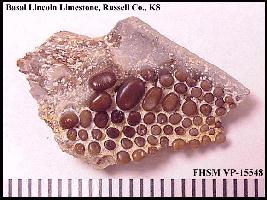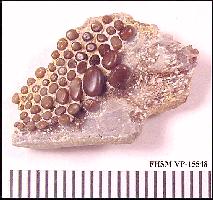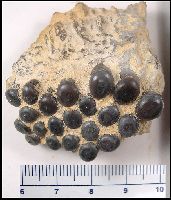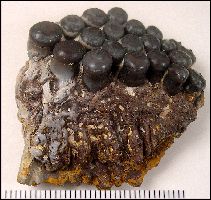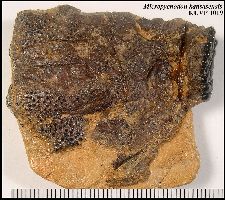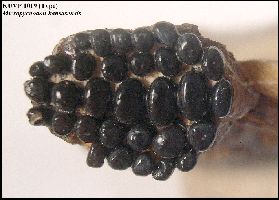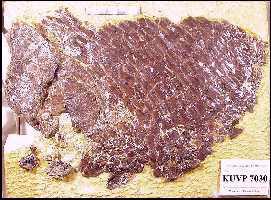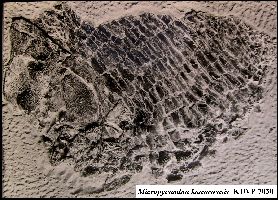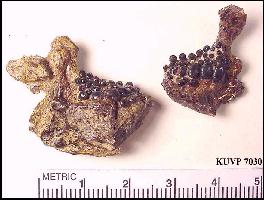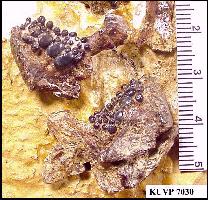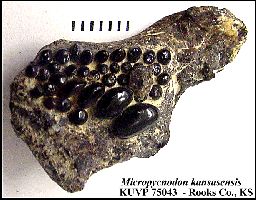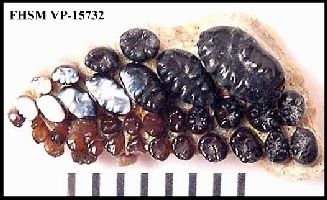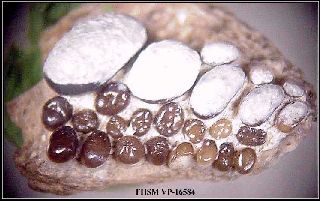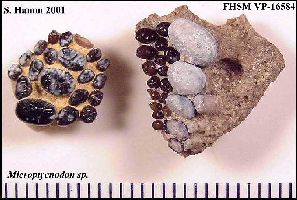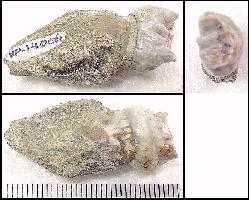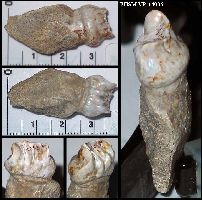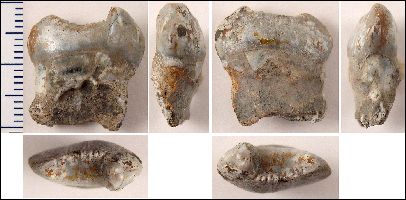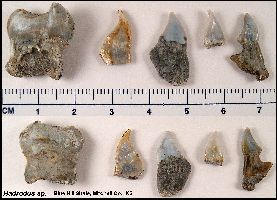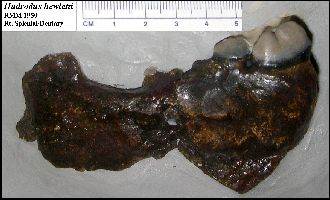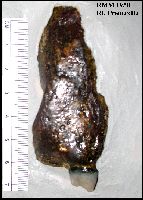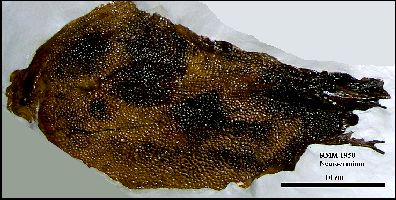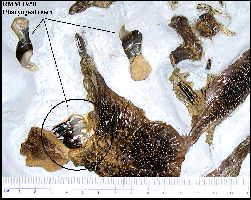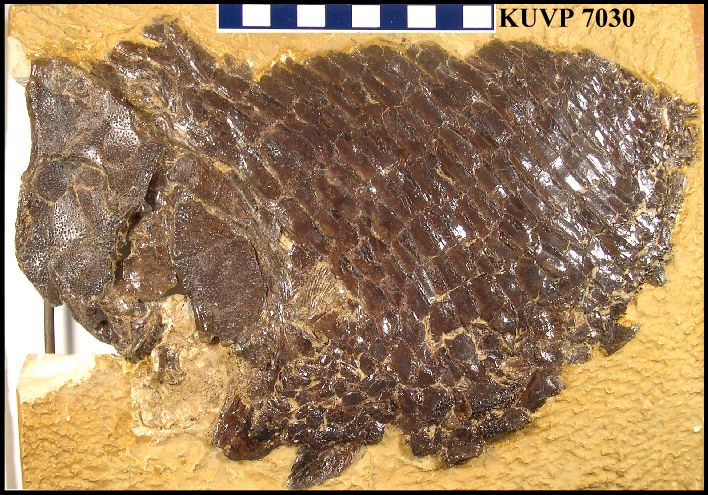 |
Pycnodontid fishes from the
Kansas Cretaceous
Copyright © 2004-2010 by Mike Everhart
Created 06/20/2004
Latest update 02/24/2010
LEFT: A nearly complete specimen of Micropycnodon
kansasensis (KUVP 7030) from the Niobrara Chalk of Trego Co., KS. The head is
to the left side of the picture. The tail (missing) would have been at the top right.
Click on photo for larger view (Described by Dunkle and Hibbard, 1946) |
Pycnodonts were small to medium-sized, deep-bodied bony fish with round,
flattened teeth that are well adapted for crushing food items. While it is possible that
these fish "nibbled" on the invertebrates and algal growths (epifauna) that were
attached to inoceramid shells at the bottom of the Western Interior Sea, it is far more
likely that they preferred shallower water nearer to shore (Manning, pers. comm., 2004).
They may have been much like the modern parrot fish in that regard. (More information here) It is quite possible that
the scattered remains that we find in the Smoky Hill Chalk are from individuals that
strayed too far from the shore and died in deep water.
Cragin (Colorado College Studies, V, 1894) described Macromesodon abrasus
(Cragin) based on isolated teeth taken from his "No. 3 of the Belvidere
section," of the Kiowa Shale, Lower Cretaceous. Williston (Kan. Univ. Quart. IX, No.
2, 1900a, pp. 28-29 [see also Williston, 1900b]) reported a fragment of the left lower jaw
containing two rows of teeth of Coelodus brownii Cope and a fragment of the lower
right jaw of Coelodus stantoni Williston from the Kiowa Shales of Kansas.
Hibbard and Graffham (1941) wrote: "The remains of Pycnodont fish have rarely been
found in the Cretaceous of Kansas." While they are no longer considered to be
rare, they are certainly uncommon discoveries.
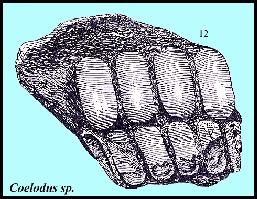 |
LEFT: (Click to
enlarge) Fragments of pycnodont tooth plates from the Kiowa Shale (Early Cretaceous,
Albian age), of south-central Kansas (Adapted from Williston 1900b, Plate XXIV): 11)
Right splenial of Coelodus stantoni Williston, and; 12) Left splenial of Coelodus
brownii Cope, Kiowa County. Note that "Coelodus"
brownii and "Coelodus" stantoni are probably not
closely related to the type species of Coelodus, C. saturnus, from the
Turonian-Santonian of Slovenia (see Poyato-A. & Wenz, 2002, p. 8). It is
difficult to accurately identify species from the isolated tooth plates that are most
commonly collected.
RIGHT: A single tooth from a Coelodus sp. splenial in occlusal, lateral and
basal views. Kiowa Shale, Clark County, KS. Scale = mm. |
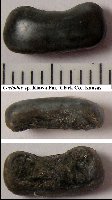 |
You can now download a
copy of this early article on Kansas sharks and pycnodonts by S.W. Williston - Provided by
the Kansas Geological Survey:
Williston, S. W. 1900. Cretaceous fishes:
Selachians and Pycnodonts. University Geological Survey Kansas VI pp. 237-256,
with pls.
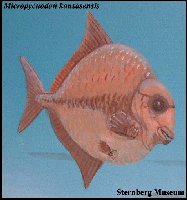 |
Systematic Paleontology:
Class Osteichthyes
Actinopterygii
Neopterygii
Pycnodontiformes |
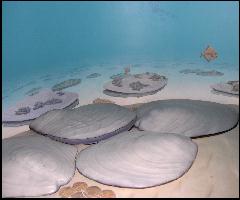 |
Hibbard and Graffham (1941) described a new species of pycnodont ("Pycnomicrodon"
kansasensis - KUVP 1019) from the Niobrara of Rooks County. However the genus
name was preoccupied, and they changed the genus name to Micropycnodon (Hibbard
and Graffham, 1945).
Over the last hundred years, a relatively small number pycnodont specimens have
been collected from Cretaceous rocks in Kansas, ranging from the Albian Kiowa Shale (Early
Cretaceous) through at least the end of the Coniacian in the Smoky Hill Chalk (See
Stewart, 1990). Most of these specimens consist of only a tooth bearing element from
the skull. This page will illustrate a variety of specimens found in Kansas,
beginning with the Early Cretaceous.
Albian (Early Cretaceous) Kiowa Shale:
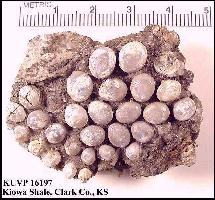 |
LEFT AND RIGHT: Two views of a partial vomerine
toothplate (KUVP 16197), possibly from a juvenile pycnodont (Kiowa Shale of Clark County, Kansas).
Collected by Orville Bonner in 1969 - possibly Coelodus brownii. (Scale = mm) |
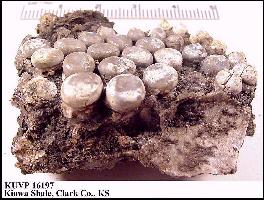 |
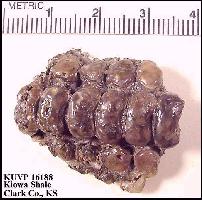 |
LEFT: A fragment of a pycnodont vomer (KUVP 16188) from the Kiowa
Shale of Clark County, Kansas. (Scale = mm) RIGHT: A
second pycnodont vomer fragment (KUVP 17408), also from the Kiowa Shale of Clark County,
Kansas. (Scale = mm)
Note that the row of largest teeth is on the midline of the roof of the mouth, and
supported above by the vomer bone. |
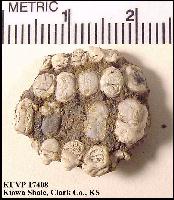 |
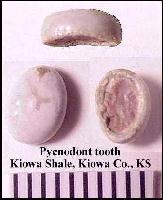 |
LEFT: Three views of a single tooth crown (Coelodus sp.),
probably vomerine, that I collected from near the base of the Kiowa Shale (Albian)
in Kiowa County, KS in 2002. (Scale = mm) RIGHT: A
weathered, partial right pre-articular toothplate, with anterior at left, and lateral at
top of Coelodus stantoni in the collection of the Sternberg Museum
(FHSM VP-7280). It is missing both the smaller medial and lateral teeth. (Scale = mm) |
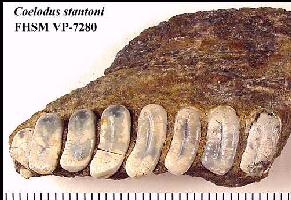 |
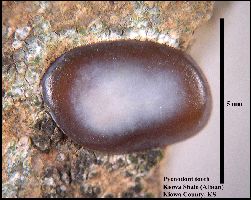 |
LEFT: Close-up of a small pycnodont tooth crown discovered in a
shelly mudstone matrix in the Kiowa Shale, about 6 m above the base, in Kiowa County,
Kansas, July 14, 2006. The greenish-white shapes around the tooth are lichens on the
surface of the rock. The whitish color of the tooth crown is due to weathering and
exposure to sunlight. RIGHT: A second pycnodont tooth (circled) in
another piece of shelly mudstone from the Kiowa Shale, Kiowa County, Kansas. There
are several other small shark and fish teeth visible in this piece of matrix. (Scale =
mm) |
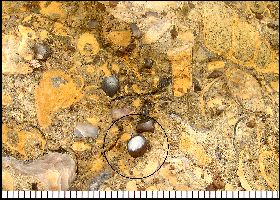 |
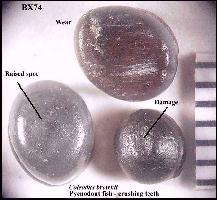 |
LEFT: Three isolated toothplate teeth collected from the Kiowa
Shale in McPherson County, Kansas. Note the evidence of wear on the tooth in the upper
right of the picture. (Scale = mm) RIGHT: Three isolated
pycnodont and two gar (Lepidotes sp.) teeth from the Kiowa Shale of McPherson
County, Kansas. Pycnodont teeth were among the most common vertebrate remains found at
this site: (See shark remains from the Kiowa Shale here.. near
bottom of page) (Scale = mm)
|
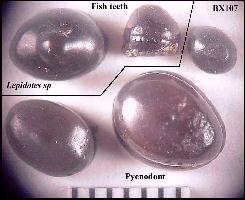 |
Middle Cenomanian (Late Cretaceous) Upper Dakota Sandstone (at the
transition to basal Graneros Shale)
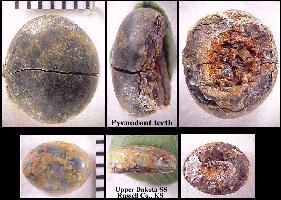 |
LEFT: Three views (left to right; occlusal, lateral,
basal) of two pycnodont teeth from the upper Dakota Sandstone, Russell County, Kansas.
Pycnodont teeth are rare occurrences at this site. (See Everhart, et al.,
2004) (Scale = mm) RIGHT: A single, nicely
preserved pycnodont splenial tooth in occlusal and basal views from the Dakota Sandstone,
Russell County, Kansas. As pycnodonts become more derived, the large medial teeth became
larger, and stretched laterally. It is likely that this occurred over time because it is
more efficient to crush food items with a few large teeth than a lot of small ones. (Scale
= mm) |
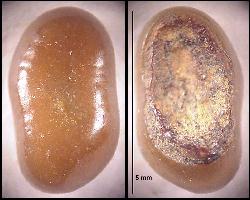 |
Middle Cenomanian (Late Cretaceous) Basal Lincoln Limestone Member,
Greenhorn Limestone Formation
Middle Turonian (Late Cretaceous) Carlile Shale
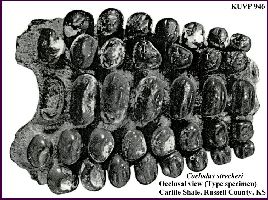 |
LEFT: An occlusal view of the type specimen of Coelodus
streckeri (KUVP 946) from the Carlile Shale of Russell County, as figured by Hibbard
(1939). (Photo of actual specimen) (Anterior view) RIGHT: The
type specimen of Coelodus streckeri (KUVP 946) in left lateral view, as figured
by Hibbard (1939). (Photo of specimen)
Both figures modified from: Hibbard, C.W. 1939. A new pycnodont
fish from the Upper Cretaceous of Russell County, Kansas. Quarterly Bulletin University of
Kansas 26: 373-375, 1 pl. |
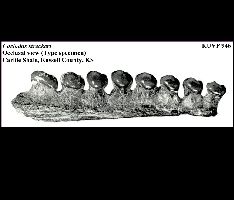 |
Middle Turonian (Late Cretaceous) Blue Hill Shale Member of the Carlile
Shale
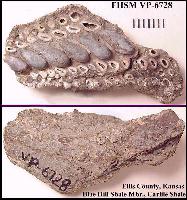 |
LEFT: FHSM VP-6728; A left prearticular toothplate of Anomoeodus
(Manning, pers. comm.,
2004). from the Blue Hill Shale Member of the
Carlile Shale of Ellis County, KS (Reported by Zielinski, 1994). (Scale = mm) RIGHT:
A possible tiny pycnodont tooth from the "Fish Tooth Conglomerate" of Hattin
(1962), Blue Hill Shale Member of the Carlile Shale, Jewell
County, Kansas (See Everhart, et al, 2003). Manning (pers. comm. 2004) believes it may be Hadrodus.
(Scale = mm) |
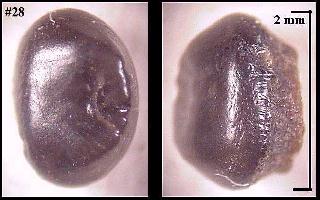 |
Late Coniacian (Late Cretaceous) Smoky Hill Chalk Member of the Niobrara
Chalk
There is some confusion regarding the stratigraphic occurrence of the type specimen
and a more complete specimen (KUVP 7030) shown below. While Hibbard & Graffham (1941,
p. 72) noted that the type specimen was from the Niobrara, this could mean the Fort Hays
Limestone or the Smoky Hill Chalk. However, Dunkle & Hibbard (1946, p. 162) said the
type, and a new specimen (KUVP 7030), was from the basal Ft. Hays Limestone Member, basal
Niobrara Formation. This was maintained by both Schultze, et al. (1982, p. 22) and Stewart
(1990, p. 21). The type locality is now beneath Webster Reservoir (Stewart, 1990, p. 21)
and is no longer accessible. Vertebrate fossils, especially articulated ones, are usually
rare in the Fort Hays but may be more common near the base (pers. obs.). My examination of
KUVP 7030 indicates that the matrix was more like the chalk than the Fort Hays Limestone,
but again, much of the basal Fort Hays is a chalky limestone. In any case, the
species does occur in the lower part (late Coniacian) of the Smoky Hill Chalk, and would
also be expected to be found in the underlying Fort Hays Limestone. The two
specimens in the lower photos are definitely from the Smoky Hill Chalk.
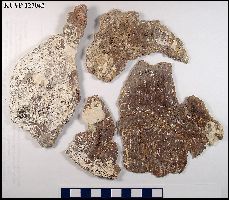 |
LEFT: A nearly complete specimen of Micropycnodon kansasensis
(KUVP 127042) in the collection of the University of Kansas Museum of Natural History
found by Laverne "Duffer" Mauck in southeastern Gove County in 1994 near
Hattin's Marker Unit 4. Head is to the left. RIGHT: A close up of the
spiky scales covering ventral side (keel) of this fish. The spines are made up of a enamel
like substance called ganoin which covers the scales and dermal bones of ganoid fish (Also
visible on the type and KUVP 7030) |
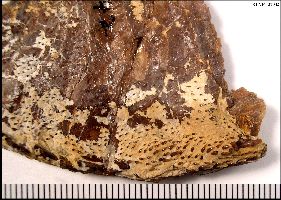 |
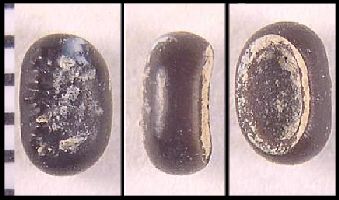 |
LEFT: A pycnodont tooth crown (FHSM VP-16583) recovered from the
coprolite at right. (Scale = mm). The coprolite was discovered about 1 m above MU6.
(See Everhart, 2007) RIGHT: A small coprolite (FHSM VP-16586) from the
lower Santonian Smoky Hill Chalk of Lane County, KS, that has a pycnodont tooth (FHSM
VP-16583) visible on the outer surface. The coprolite also contained other fish teeth,
bone fragments and inoceramid (?!) fragments. |
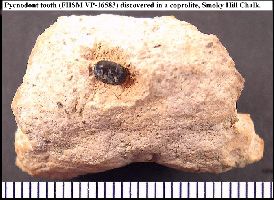 |
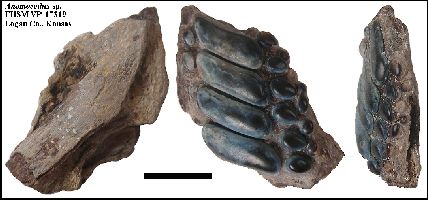 |
LEFT: The right prearticular of Anomoeodus
sp. (FHSM VP-17319) from the upper Smoky Hill Chalk, Logan County, Kansas; collected by
Pete Bussen in 1974. Shown here (Left to right) in basal, occlusal and lateral views.
See: Shimada, K. and
Everhart, M.J. 2009. First record of Anomoeodus (Osteichthyes: Pycnodontiformes)
from the Upper Cretaceous Niobrara Chalk of western
Kansas. Kansas Academy of Science, Transactions 112(1/2):98-102. |
About Hadrodus: (Earl
Manning, pers. comm. 2004)
There are several things you can say about Hadrodus. Although it's not a
pycnodontiform (Poyato-Ariza, F.J., and
S. Wenz, 2002), it is very likely closely related to them, as shown by
its deep-bodied form (seen in a partially-described Alabama specimen), the increased
number and enlarged size of the vomerine and prearticular teeth, and the incisor-like
anterior teeth (they're more like human incisors in pycnodonts, not as broad as in Hadrodus).
Unlike pycnodontiform toothplate teeth, the teeth of Hadrodus are not arranged in
regular rows, nor are some teeth especially enlarged and elongate. Hadrodus
doesn't really have regular toothplates, the way pycnodonts do. The mandibular symphysis
is oriented differently in the two taxa - it's nearly vertical, and anteriormost in Hadrodus,
but nearly horizontal and largely medial in pycnodonts. Thurmond is probably correct
to place Hadrodus in a separate family, the Hadrodontidae Thurmond, in
Thurmond and Jones (1981, p. 82). Both likely ate hard-shelled prey. Both Hadrodus
and the pycnodonts probably derive from the Late Jurassic/Early Cretaceous lepidotids,
which were also deep-bodied bony fish, and had enlarged oral cavity teeth.
The type specimen of the type species, H. priscus Leidy, 1858 (figured in
Leidy, 1873, pl. 19, figs. 17-20) is an adult left premaxilla, likely from the Late
Santonian of northeast Mississippi. Adult specimens have been found in the deep water
chalks of Alabama (Applegate, 1970 [partly under the name "Propenser"];
Thurmond & Jones, 1981, pp. 82-3; and Bell, 1986 - the last a partially-described
nearly complete skeleton) and Kansas (a lower jaw collected in Logan Co. by the
Marsh party in 1872, and described by Gregory, 1950). It is also known from far more
abundant, and far smaller, isolated juvenile teeth (ant., oral cavity, and distinctive
hook-like pharyngeal teeth [sometimes called "Ancistrodon" or "Stephanodus"]
- which are associated with the oral cavity teeth in some Alabama specimens [Thurmond
& Jones, 1981; and Bell, 1986]), which are almost always found in far shallower marine
water (Manning and Dockery, 1992, p. 12, pl. 9, figs. 5-6). How the comb-like pharyngeal
tooth structure (Thurmond and Jones, 1981, fig. 39, nos. 1,2, 5, and 6) was used is
uncertain, but it may have strained out small food particles from crushed prey, going down
the throat. It appears that the young lived in protected inner waters, while the
adults lived in deeper, open water. On the Gulf and Atlantic Coastal Plain, Hadrodus
isolated teeth, especially the small juvenile teeth, are known from Late Cretaceous marine
beds from Texas to New Jersey. In Kansas, Hadrodus has a long range (nearly as
long as its Late Cretaceous beds), from the Middle Cenomanian up. Dakota / lower Graneros
shales to the Early Campanian upper Smoky Hill Chalk. They are commonly found as
juveniles in shallow-water deposits, and rare adults in deep-water deposits.
|
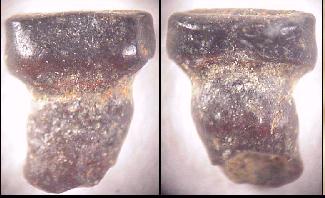 |
LEFT: Three views of a juvenile Hadrodus incisor from the
upper Dakota Sandstone (Middle Cenomanian) of Russell county, KS. (Scale = mm) RIGHT:
Two Hadrodus pharyngeal teeth from the upper Dakota Sandstone (Middle Cenomanian)
of Russell county, KS.
FAR RIGHT: Juvenile Hadrodus incisors and pharyngeal teeth from
the Blue Hill Shale Member of the Carlile Shale, Jewell County, KS. (Scale = mm)
|
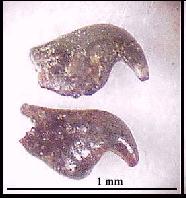 |
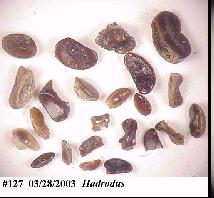 |
Other
Oceans of Kansas webpages on Late Cretaceous fish:
Field Guide to Sharks and Bony
Fish of the Smoky Hill Chalk
Sharks:
Kansas Shark Teeth
Cretoxyrhina and Squalicorax
Ptychodus
Chimaerids
Bony Fish
Pycnodonts and Hadrodus
Plethodids:
Pentanogmius
Martinichthys
Thryptodus
Bonnerichthys
Protosphyraena
Enchodus
Cimolichthys
Pachyrhizodus
Saurodon and Saurocephalus
Xiphactinus
REFERENCES:
Bell, G. L., Jr. 1986. A pycnodont fish from the upper Cretaceous
of Alabama. Journal of Paleontology 60(5):1120-1126, 2 figs.
Everhart, M. J. 2007. Remains of a pycnodont fish (Actinopterygii:
Pycnodontiformes) in a coprolite; An upper record of Micropycnodon
kansasensis in the Smoky Hill Chalk, western Kansas. Kansas Academy
of Science, Transactions 110(1/2): 35-43.
Everhart, M. J., P. A. Everhart and K. Ewell. 2004. A marine
ichthyofauna from the Upper Dakota Sandstone (Late Cretaceous). Abstracts of oral
presentations and posters, Joint Annual Meeting of the Kansas and Missouri Academies of
Science, p. 48.
Everhart, M. J., P. Everhart, E. M. Manning, and D. E. Hattin.
2003. A Middle Turonian marine fish fauna from the Upper Blue Hill Shale Member, Carlile
Shale, of north central Kansas. Journal of Vertebrate Paleontology, Volume 23 (Supplement
to Number 3): 49A.(Abstract)
Dunkle, D.H. and Hibbard, C.W. 1946. Some comments upon the
structure of a pycnodontid fish from the upper Cretaceous of Kansas. University Kansas
Science Bulletin 31 (8):161-181, pt. 1.
Gidley, J. W. 1913. Some new American pycnodont fishes. Proc. U. S.
National Museum, No. 2036, 46:445-449.
Gregory, J. T. 1950. A large pycnodont from the Niobrara Chalk.
Postilla (5):10 p. (Hadrodus)
Hattin, D. E. 1962. Stratigraphy of the Carlile Shale (Upper
Cretaceous) in Kansas. State Geological Survey of Kansas, Bulletin 156, (University of
Kansas pub.) 155 p. 2 pl.
Hibbard, C. W. 1939. A new pycnodont fish from the Upper Cretaceous
of Russell County, Kansas. Quarterly Bulletin University of Kansas 26: 373-375, 1 pl.
Hibbard, C. W. and A. Graffham. 1941. A new pycnodont fish from the
Upper Cretaceous of Rooks County, Kansas. Quarterly Bulletin University of Kansas
27:71-77, 1 fig., 1 pl.
Hibbard, C. W. and A. Graffham. 1945. Micropycnodon, new
name for Pycnomicrodon Hibbard and Graffham not Hay. Kansas Academy of
Science, Transactions 47(3):404.
Hussakof, L. 1947. A new pycnodont fish from the Cretaceous of
Arkansas. Fieldiana - Geology 10(4):23-27.
Manning, E. M. and D. T. Dockery III. 1992. A guide to the
Frankstown vertebrate fossil locality (upper Cretaceous), Prentiss County, Mississippi.
Mississippi Department Environmental Quality, Office of Geology, Circular 4, 43 p. 2 pl.
Poyato-Ariza, F.J. and S. Wenz.
2002. A new insight into
pycnodontiform fishes. Geodiversitas, 24(1):139-248. (PDF File)
Shimada, K. and Everhart, M.J. 2009. First
record of Anomoeodus (Osteichthyes: Pycnodontiformes) from the Upper
Cretaceous Niobrara Chalk of western Kansas.
Kansas Academy of Science, Transactions 112(1/2):98-102.
Stewart, J. D. 1990. Niobrara Formation vertebrate stratigraphy, pages 19-30, In
Bennett, S. C. (ed.), Niobrara Chalk Excursion Guidebook, The University of Kansas
Museum of Natural History and the Kansas Geological Survey.
Thurmond, J. T. and D. E. Jones. 1981. Fossil vertebrates of
Alabama. University of Alabama Press. Tuscaloosa, ix + 244 p., 88 text figs. (Family
Hadrodidae)
Williston, S. W. 1900a. Some fish teeth from the Kansas Cretaceous.
Kansas University Quarterly 9( 2):28-29.
Williston, S. W. 1900. Cretaceous fishes [of
Kansas]. Selachians and Pycnodonts. University Geological Survey Kansas VI pp.
237-256, with pls.
Zielinski, S. L. 1994. First report of Pycnodontidae (Osteichthyes)
from the Blue Hill Shale Member of the Carlile Shale (Upper Cretaceous; Middle Turonian),
Ellis County, Kansas. Kansas Academy of Science, Abstracts 13(44).
CREDITS: I thank Earl Manning (Tulane
University) for the review and comments which have improved the accuracy and content of
this webpage.

















